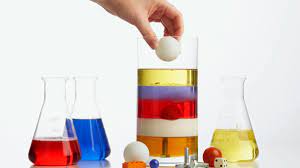Unit of Density: Formula, Examples & Applications

Density is defined as the denseness of a particular material in a specific area. The SI unit of Density is kg/m3. For solids, the unit of density is g/cm3 and g/ml for liquids and g/L for gases. Every substance has a specific density which means for the same volume, different substances weigh differently. The density of a material also refers to its mass per unit volume which measures how tightly the particles are packed together.
Density can be expressed in terms of different metrics as listed below-
- t/m3- Metric ton per cubic meter
- g/ml- Gram per milliliter
- kg/l- Kilogram per liter
- g/cm3- Gram per cubic centimeter
- mg/m3- Megagram per cubic meter
- kg/dm3- Kilogram per cubic decimeter
Examples of Density
In the case of solid substances like iron, platinum, steel, minerals are dense. Materials with high density are hard and likely to feel heavy.
Materials like Styrofoam, Glass, Bamboo are light in weight so they’re not very dense. The particles collide with each other. Whereas, In case of liquid they are denser than gases.
In gases the material moves freely all over the place which makes it less dense than liquid and solid.
Density of Gas, Liquid and Solid
Formula of Density
Density can be defined as the relationship between the mass of a substance and the volume the substance occupies. It indicates how heavy an object is when the volume is constant. Mathematically, density of an object is expressed as follows-
Density=MassVolume
p=mv
Where, p = Density, m = mass and v = volume
∴ Density=MassVolume=gcm3=gmL
Types of Density
There are two classifications of Density-
Absolute Density: Absolute density refers to the mass of substance per unit volume of a material. It’s expressed as g/cm3.
Relative Density: Relative density is the ratio of the density of a material to the density of a reference substance. The reference material is usually water. Relative density is called specific gravity and is a relative quantity with no units.
Applications of Density
Real life examples of density are pipe designing, building a ship, helium balloons, weight distribution in an airplane and ice floating on water.
- If two balloons are filled with air and one with coke. The balloon with coke is much denser because the atoms around the coke will move around less and take less space. Whereas, in the balloon with air, the atoms will collide with each other quickly and take more space. Thus, the balloon with air will have less density and balloon with coke will have more density.
- Ships can float on water because they are designed with tanks which hold up air, These tanks offer large volumes with very little mass which decreases the density of the ship. Combined with buoyant force it helps the ship to float on water.
Density is expressed in units of grams per cubic centimetre. Density is measured in a specific area. The SI unit of Density is kg/m3. A block of a heavier element such as lead (Pb) will be denser than a softer element such as gold (Au). Each element and compound has a unique density.



